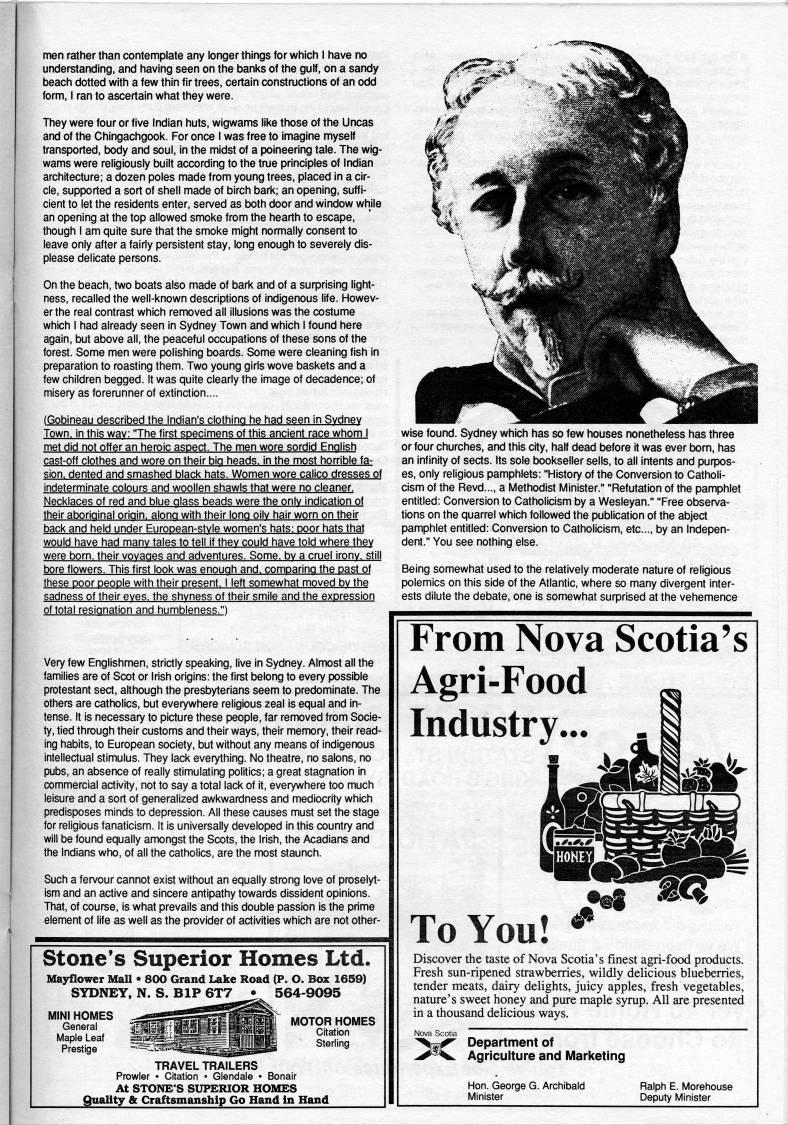Page 53 - Gobineau: Cape Breton's People, 1859
Published by Ronald Caplan on 1990/6/1 (164 reads)men rather than contemplate any longer things for which I have no understanding, and having seen on the banks of the gulf, on a sandy beach dotted with a few thin fir trees, certain constructions of an odd form, I ran to ascertain what they were. They were four or five Indian huts, wigwams like those of the Uncas and of the Chingachgook. For once I was free to imagine myself transported, body and soul, in the midst of a poineering tale. The wig? wams were religiously built according to the true principles of Indian architecture; a dozen poles made from young trees, placed in a cir? cle, supported a sort of shell made of birch bari<; an opening, suffi? cient to let the residents enter, served as both door and window while an opening at the top allowed smoke from the hearth to escape, though I am quite sure that the smoke might nomrially consent to leave only after a fairly persistent stay, long enough to severely dis? please delicate persons. On the beach, two boats also made of bark and of a surprising light? ness, recalled the well-known descriptions of indigenous life. Howev? er the real contrast which removed all illusions was the costume which I had already seen in Sydney Town and which I found here again, but above all, the peaceful occupations of these sons of the forest. Some men were polishing boards. Some were cleaning fish in preparation to roasting them. Two young girts wove baskets and a few children begged. It was quite clearty the image of decadence; of misery as forerunner of extinction.... (Gobineau described the Indian's clothing he had seen in Svdnev Town, in this wav: "The first specimens of this ancient race whom I met did not offer an heroic aspect. The men wore sordid English cast-off clothes and wore on their bio heads, in the most horrible fa- sion, dented and smashed black hats. Women wore calico dresses of indeterminate colours and woollen shawls that were no cleaner- Necklaces of red and blue glass beads were the oniv indication of their aboriginal origin, along with their long oilv hair worn on their back and held under European-stvie women's hats; poor hats that would have had many tales to tell if thev could have told where thev were born, their vovages and adventures. Some, bv a cruel irony, still bore flowers. This first look was enough and, comparing the past of these poor people with their present, I left somewhat moved bv the sadness of their eyes, the shyness of their smile and the expression of total resignation and humbleness.") Very few Englishmen, strictly speaking, live in Sydney. Almost all the families are of Scot or Irish origins: the first belong to every possible protestant sect, although the presbyterians seem to predominate. The others are catholics, but everywhere religious zeal is equal and in? tense. It is necessary to picture these people, far removed from Socie? ty, tied through their customs and their ways, their memory, their read? ing habits, to European society, but without any means of indigenous intellectual stimulus. They lack everything. No theatre, no salons, no pubs, an absence of really stimulating politics; a great stagnation in commercial activity, not to say a total lack of it, everywhere too much leisure and a sort of generalized awkwardness and mediocrity which predisposes minds to depression. All these causes must set the stage for religious fanaticism. It is universally developed in this country and will be found equally amongst the Scots, the Insh, the Acadians and the Indians who, of all the catholics, are the most staunch. Such a fervour cannot exist without an equally strong love of proselyt- ism and an active and sincere antipathy towards dissident opinions. That, of course, is what prevails and this double passion is the prime element of life as well as the provider of activities which are not other- Stone's Superior Homes Ltd. Mayflower Mall • 800 Grand Lake Road (P. O. Box 1659) SYDNEY, N. S. BIP 6T7 t. 564-9095 MOTOR HOMES Citation Sterling TRAVEL TRAILERS Prowler • Citation • Glendale • Bonair At STONE'S SUPERIOR HOMES Quality & Craftsmanship Go Hand in Hand wise found. Sydney which has so few houses nonetheless has three or four churches, and this city, half dead before it was ever born, has an infinity of sects. Its sole bookseller sells, to all intents and purpos? es, only religious pamphlets: "History of the Conversion to Catholi? cism of the Revd..., a Methodist Minister." "Refutation of the pamphlet entitled: Conversion to Catholicism by a Wesleyan." "Free observa? tions on the quarrel which followed the publication of the abject pamphlet entitled: Conversion to Catholicism, etc., by an Indepen? dent." You see nothing else. Being somewhat used to the relatively moderate nature of religious polemics on this side of the Atlantic, where so many divergent inter? ests dilute the debate, one is somewhat surprised at the vehemence From Nova Scotia's Agri-Food Industry... To You! ' Discover the taste of Nova Scotia's finest agri-food products. Fresh sun-ripened strawberries, wildly delicious blueberries, tender meats, dairy delights, juicy apples, fresh vegetables, nature's sweet honey and pure maple syrup. All are presented in a thousand deUcious ways. Nova Scotia '- • -~ • - • • '' • • ---''-''------'''''' • • -- • • • • • ">ra<' Department of 'i$i' Agriculture and Marketing Hon. George G. Archibald Minister Ralph E. Morehouse Deputy Minister
Adobe Acrobat Reader is required to the PDF version of this content. Click here to download and install the Acrobat plugin





